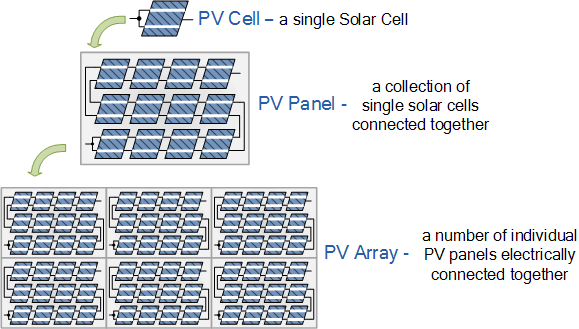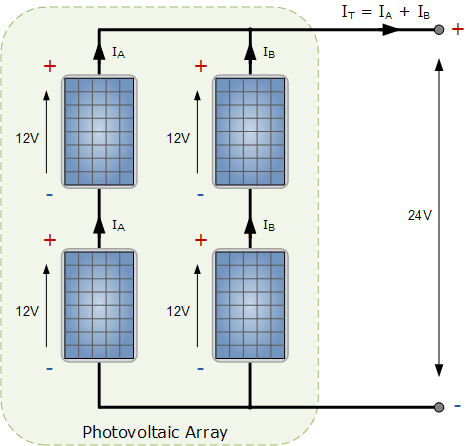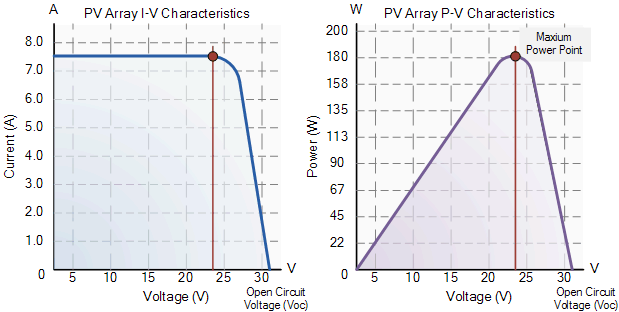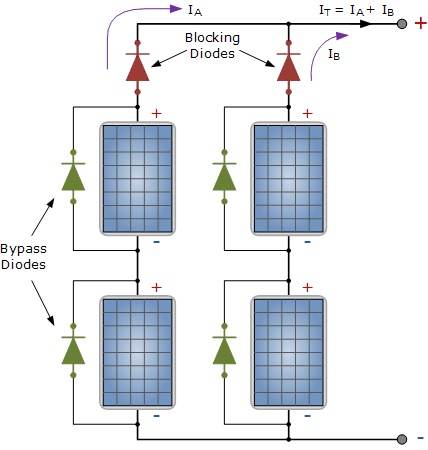The Solar Photovoltaic Array
A complete photovoltaic system uses a photovoltaic array as the main source for the generation of the electrical power supply. The amount of solar power produced by a single photovoltaic panel or module is not enough for general use. Most manufactures produce standard PV panels with an output voltage of 12V or 24V. By connecting many single PV panels in series (for a higher voltage requirement) and in parallel (for a higher current requirement) the PV array will produce the desired power output.
A Photovoltaic Solar Array

Photovoltaic cells and panels convert the solar energy into direct-current (DC) electricity. The connection of the solar panels in a single photovoltaic array is same as that of the PV cells in a single panel. The panels in an array can be electrically connected together in either a series, a parallel, or a mixture of the two, but generally a series connection is chosen to give an increased output voltage. For example, when two solar panels are wired together in series, their voltage is doubled while the current remains the same.
The size of a photovoltaic array can consist of a few individual PV modules or panels connected together in an urban environment and mounted on a rooftop, or may consist of many hundreds of PV panels interconnected together in a field to supply power for a whole town or neighbourhood. The flexibility of the modular photovoltaic array (PV system) allows designers to create solar power systems that can meet a wide variety of electrical needs, no matter how large or small.
It is important to note that photovoltaic panels or modules from different manufacturers should not be mixed together in a single array, even if their power, voltage or current outputs are nominally similar. This is because differences in the I-V characteristic curves of the panels as well as their spectral response are likely to cause extra mismatch losses in the array reducing its efficiency.
The Electrical Characteristics of a Photovoltaic Array
The electrical characteristics of a photovoltaic array are summarised in the relationship between the output current and voltage. The amount and intensity of solar insolation (solar irradiance) controls the amount of output current ( I ), and the operating temperature of the solar cells affects the output voltage ( V ) of the PV array. Photovoltaic panel ( I-V ) curves that summarise the relationship between the current and voltage are given by the manufacturers and are given as:
Solar Array Parameters
- • VOC = open-circuit voltage: – This is the maximum voltage that the array provides when the terminals are not connected to any load (an open circuit condition). This value is much higher than Vmax which relates to the operation of the PV array which is fixed by the load. This value depends upon the number of PV panels connected together in series.
- • ISC = short-circuit current – The maximum current provided by the PV array when the output connectors are shorted together (a short circuit condition). This value is much higher than Imax which relates to the normal operating circuit current.
- • Pmax = maximum power point – This relates to the point where the power supplied by the array that is connected to the load (batteries, inverters) is at its maximum value, where Pmax = Imax x Vmax. The maximum power point of a photovoltaic array is measured in Watts (W) or peak Watts (Wp).
- • FF = fill factor – The fill factor is the relationship between the maximum power that the array can actually provide under normal operating conditions and the product of the open-circuit voltage times the short-circuit current, ( Voc x Isc ) This fill factor value gives an idea of the quality of the array and the closer the fill factor is to 1 (unity), the more power the array can provide. Typical values are between 0.7 and 0.8.
- • %eff = percent efficiency – The efficiency of a photovoltaic array is the ratio between the maximum electrical power that the array can produce compared to the amount of solar irradiance hitting the array. The efficiency of a typical solar array is normally low at around 10-12%, depending on the type of cells (monocrystalline, polycrystalline, amorphous or thin film) being used.
Photovoltaic I-V characteristics curves provide the information designers need to configure systems that can operate as close as possible to the maximum peak power point. The peak power point is measured as the PV module produces its maximum amount of power when exposed to solar radiation equivalent to 1000 watts per square metre, 1000 W/m2 or 1kW/m2. Consider the circuit below.
Photovoltaic Array Connections

This simple photovoltaic array above consists of four photovoltaic modules as shown, producing two parallel branches in which there are two PV panels that are electrically connected together to produce a series circuit. The output voltage from the array will therefore be equal to the series connection of the PV panels, and in our example above, this is calculated as: Vout = 12V + 12V = 24 Volts.
The output current will be equal to the sum of the parallel branch currents. If we assume that each PV panel produces 3.75 amperes at full sun, the total current ( IT ) will be equal to: IT = 3.75A + 3.75A = 7.5 Amperes. Then the maximum power of the photovoltaic array at full sun can be calculated as: Pout = V x I = 24 x 7.5 = 180W.
The PV array reaches its maximum of 180 watts in full sun because the maximum power output of each PV panel or module is equal to 45 watts (12V x 3.75A). However, due to different levels of solar radiation, temperature effect, electrical losses etc, the real maximum output power is usually a lot less than the calculated 180 watts. Then we can present our photovoltaic array characteristics as being.
Photovoltaic Array Characteristics

Diodes in Photovoltaic Arrays
Photovoltaic cells and diodes are both semiconductor devices made from a P-type silicon material and a N-type silicon material fused together. Unlike a photovoltaic cell which generates a voltage when exposed to light, PN-junction diodes act like solid state one way electrical valve that only allows electrical current to flow through themselves in one direction only. The advantage of this is that diodes can be used to block the flow of electric current from other parts of an electrical solar circuit. When used in a photovoltaic solar array, these types of silicon diodes are generally called Blocking Diodes.
In the previous tutorial about photovoltaic panels, we saw that “bypass diodes” are used in parallel with either a single or a number of photovoltaic solar cells to prevent the current(s) flowing from good, well-exposed to sunlight PV cells overheating and burning out weak or partially shaded PV cells by providing a current path around the bad cell. Blocking diodes are used differently than bypass diodes.
Bypass diodes are usually connected in “parallel” with a PV cell or panel to shunt the current around it, whereas blocking diodes are connected in “series” with the PV panels to prevent current flowing back into them. Blocking diodes are therefore different then bypass diodes although in most cases the diode is physically the same, but they are installed differently and serve a different purpose. Consider our photovoltaic solar array below.
Diodes in Photovoltaic Arrays

As we said earlier, diodes are devices that allow current to flow in one direction only. The diodes coloured green are the familiar bypass diodes, one in parallel with each PV panel to provide a low resistance path around the panel. However, the two diodes coloured red are referred to as the “blocking diodes”, one in series with each series branch. These blocking diodes ensure that the electrical current only flows OUT of the series array to the external load, controller or batteries.
The reason for this is to prevent the current generated by the other parallel connected PV panels in the same array flowing back through a weaker (shaded) network and also to prevent the fully charged batteries from discharging or draining back through the PV array at night. So when multiple PV panels are connected in parallel, blocking diodes should be used in each parallel connected branch.
Generally speaking, blocking diodes are used in PV arrays when there are two or more parallel branches or there is a possibility that some of the array will become partially shaded during the day as the sun moves across the sky. The size and type of blocking diode used depends upon the type of photovoltaic array. Two types of diodes are available for solar power arrays: the PN-junction silicon diode and the Schottky barrier diode. Both are available with a wide range of current ratings.
The Schottky barrier diode has a much lower forward voltage drop of about 0.4 volts as opposed to the PN diodes 0.7 volt drop for a silicon device. This lower voltage drop allows a savings of one full PV cell in each series branch of the solar array therefore, the array is more efficient since less power is dissipated in the blocking diode. Most manufacturers include blocking diodes within their PV modules simplifying the design.
Build your own Photovoltaic Array
The amount of solar radiation received and the daily energy demand are the two controlling factors in the design of the photovoltaic array and solar power systems. The photovoltaic array must be sized to meet the load demand and account for any system losses while the shading of any part of the solar array will significantly reduce the output of the entire system.
If the solar panels are electrically connected together in series, the current will be the same in each panel and if panels are partially shaded, they cannot produce the same amount of current. Also shaded PV panels will dissipate power and waste as heat rather than generate it and the use of bypass diodes will help prevent such problems by providing an alternative current path.
Blocking diodes are not required in a fully series connected system but should be used to prevent a reverse current flow from the batteries back to the array during the night or when the solar irradiance is low. Other climatic conditions apart from sunlight must be considered in any design.
Since the output voltage of silicon solar cell is a temperature related parameter, the designer must be aware of the prevailing daily temperatures, both extremes (high and low) and seasonal variations. In addition, rain and snowfall must be considered in the design of the mounting structure. Wind loading is especially important in mountain top installations.
In the next tutorial about “Solar Power”, we will look at how we can use photovoltaic arrays and panels as part of a Stand Alone PV System to generate power for off-grid applications.
http://www.alternative-energy-tutorials.com/solar-power/pv-array.html


ليست هناك تعليقات:
إرسال تعليق